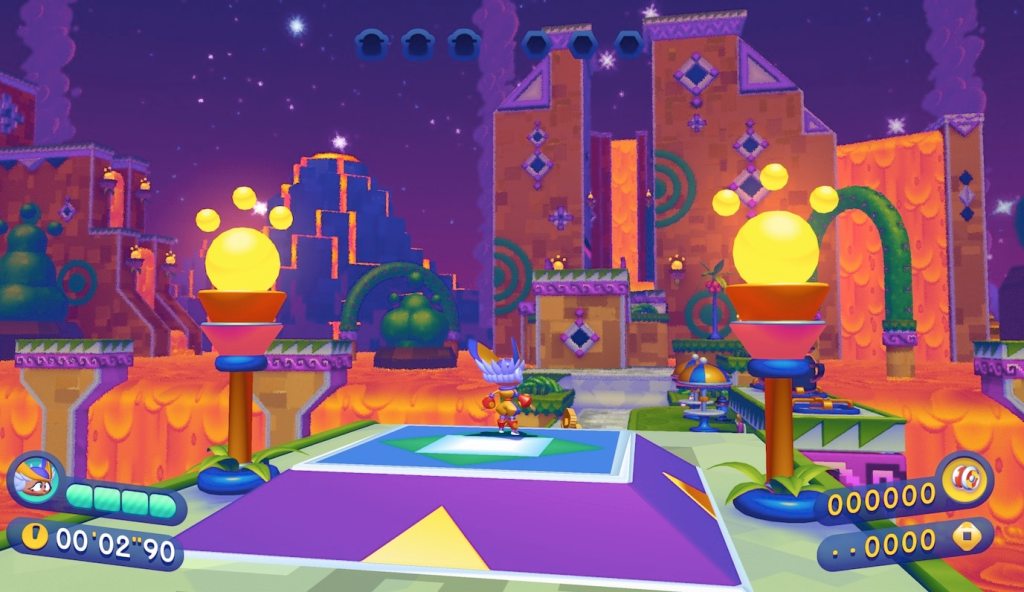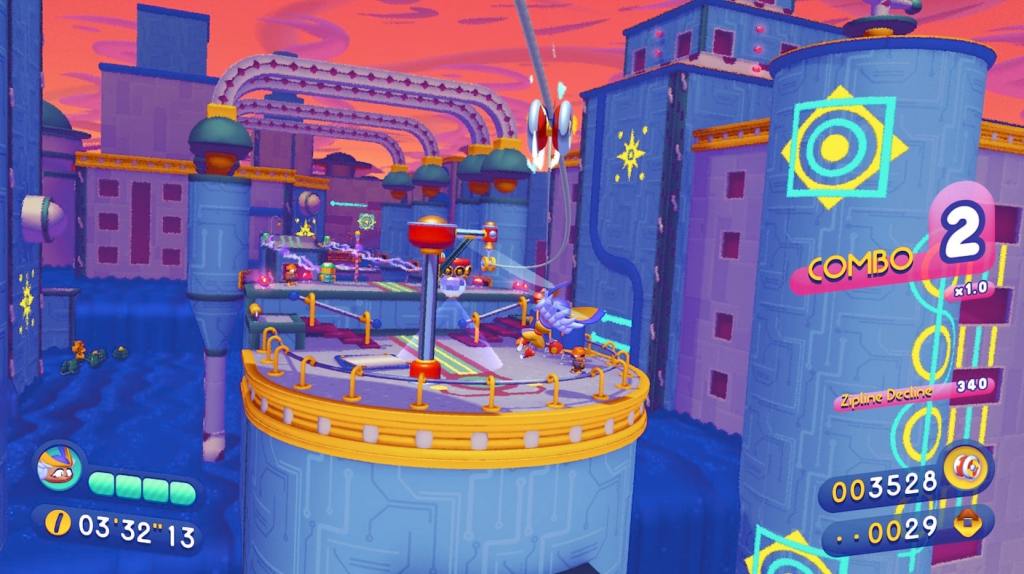Penny’s Big Breakaway is a newly-released 3D platformer that draws inspiration from the past, in its nostalgia-infused approach to adventuring. There are wisps of the classics in its design, suggested by its traversal, art style, and cutesy approach to storytelling. But this is an original tale, designed to evoke the past, while pushing forward into the future.
For game director Christian Whitehead, creating Penny’s Big Breakaway was the chance to break out, to prove his merits as a developer whose roots were originally laid in Sonic fan games, developed as a teenager living in Melbourne, Australia.
Sonic origins
“As a kid, my first system that I ever played on was the Sega Mega Drive,” Whitehead told GamesHub. “I just remember being fascinated with games, I literally thought it was magic … I was about 12 years old [when] I started seeing how I [could] make a game on a computer. There was some pretty basic software by today’s standards, there was a program called Klik & Play – I just made a lot of little stupid games.”
One of the games created by Whitehead was called Space Cows, and it allowed players to fly around in space, with cows trying to attack the player. As Whitehead’s interest in creating games developed, he moved onto more complex projects, using the Sonic series as a jumping off point.
“I was really keen to make another 2D Sonic game, because by that stage Sega wasn’t making consoles anymore. I wanted to play more Sonic!” Whitehead said. “So I was like, “oh, I’ll learn how to do it myself.” There was a whole community around it, so I got into that scene. There was a lot of people researching how those games worked – how you could make mods to make new level maps. I didn’t really do mod stuff, I was more interested in learning how to program.”

Whitehead started off with books on the C++ programming language and DirectX, and wielded knowledge from this research to create his first formal project: a retro Sonic game released on the internet. Initially, he considered this work a hobby.
“I wasn’t really expecting to make games professionally,” he said. “I was more interested in doing short films and music videos – but what really changed was when the iPhone came out, smaller developers were making games. That was a revival of the bedroom coder scene.”
Inspired by the rise of smaller developers working on mobile titles, Whitehead turned focus to a new, ambitious project: bringing a Sonic game to mobile, with the support of Sega. While the studio had released the first Sonic game on mobile, Whitehead noted disappointment that it was a simple emulated ROM. He believed he could do better, and so he initiated a pitching process with Sega.
“I ended up putting a pitch together [for Sonic CD on mobile] in 2009,” Whitehead said. “I put a video up on YouTube, and I was lucky, because Sega had put out a social media message asking ‘what games should we do on the phone?’ So I put this video up, saying I’ve got a version of Sonic running on the phone – please contact me. I’d love to do it.”
“It took about a year and a half to convince them I was legit – because they were initially really freaked out because ‘how is this guy making Sonic, we didn’t give him any source code or anything.’ I was like ‘no, no, I literally just worked out how Sonic works.'”
After conversations progressed, Whitehead was hired to make several releases for Sega – Sonic CD, and the first two Sonic games for mobile. Pleased with Whitehead’s work, Sega later allowed development on Sonic Mania, a “fan game” remix that paid homage to the history of Sonic the Hedgehog.
Following positive reception from fans, Whitehead took another leap – to co-form his own studio, Evening Star, with other developers who had aided work on Sonic Mania.
On the importance of fan games
While Evening Star was established as a professional studio to work on original game projects – including Penny’s Big Breakway – Whitehead still reveres his time as a fan game developer, and believes creating fan games is a valid and useful pathway for aspiring creators.
“Leaving legality aside, there are some aspects of [creating fan games] that are quite helpful – say, if you’re an individual person and you’re good at one thing, but you can’t do everything. It’s really hard to make a game by yourself,” Whitehead explained. “Let’s say you don’t have access to an artist or a game designer, or maybe you don’t know what good game design is. [Fan games give] you an opportunity to be like, ‘okay, how does this game do things, and what’s good about it?’ So, the simple act of trying to recreate something helps you learn the process of making a game.”
Whitehead acknowledged that fan games exist in murky legal waters, and that some companies take more litigious approaches to protecting their IP, but still believes in the value of their creation. And where creating fan games isn’t possible, he also recommends experimenting with free game assets and engines, and exploring resources online.
“Every company is different,” Whitehead said. “I think if you’re going to do a fan game, you should do it from the perspective of, ‘how can I learn and then grow my original skills’ in whatever gaming field you’re interested in.”

“Everyone starts somewhere. Don’t think too much about [causing trouble with fan games] if you’re young and just starting out, because you’re probably not going to do something that will anger one of the major companies, unless you’re trying to make money from it. If you’re just doing it at home, it’s probably fine.”
And as Whitehead’s journey attests, skills learned from working on fan projects can lead to greater opportunities. With time and attention, those who start with fan games and smaller experiments can graduate to greater heights.
Penny’s Big Breakaway, Whitehead’s new game with Evening Star and Private Division, released in February 2024, has already achieved strong reviews on Steam, and high praise for its unique approach to platformer gameplay.
Breaking away
The game, which was in development across multiple time zones in Australia, the United Kingdom and the United States, was created as a reflection of the development team’s past with classic platformers, and with appreciation for that era in gaming.
“What was really interesting for me is I remember the period of time going from Super
“With Penny’s Big Breakaway, we have a single move set that you’re basically granted immediately – but then it takes you time to master, and actually work out how you can best use it to navigate through the game … I’d say there’s a bit of Dreamcast / GameCube DNA, but we’re not explicitly chasing nostalgia, it just naturally comes through … It was really interesting reading a lot of people being like, ‘oh this is a long lost Sega Saturn game.'”
Initially, the team aimed to create a modern 3D platformer, and the ideas for Penny’s Big Breakway flew from there. As a result of Evening Star being comprised of retro game enthusiasts, the flavour of this era shines through – but with a unique approach to art and game design, it also feels like a wholly different experience.

From conceptual building blocks, Whitehead and Evening Star fleshed out the ideas for Penny’s Big Breakaway. The game’s yo-yo functioning as a weapon and vehicle was decided quickly, in the earliest stages of the game. Then came the idea for a more humorous story, filled with quirky characters like Penny, and the over-the-top Eddie the Emperor.
Then, the game’s penguins – which serve as a time limiter for players – were created. In each stage, these penguins can break into the action, herding Penny through levels, and ensuring players are kept in high-stress, high-pressure situations.
“What’s the type of enemy that would be relatively harmless, that you couldn’t run into, and it wouldn’t take health away from you, but then it escalates if you ignore it?” Whitehead said. “That [concept] led to the idea of being mobbed by a crowd, where if one person gets you, it’s not a big deal, but then if you get a whole swarm of people around you, then it would be really hard to get out of that crowd.”
In practice, the mechanic is one of Penny’s Big Breakaway‘s most engaging features. When the penguins appear, you know you’re on a time limit. You need to maximise your yo-yo swings, avoid obstacles, run faster, and achieve flow – or you’ll be mobbed by penguins, and captured for the Emperor.
Risk and reward
Speaking to Whitehead, the pride he has in Penny’s Big Breakaway is clear. As his first original project, it’s a game he’s been able to freely shape, with a dedicated team, and ample support.
“It was a lot of fun,” he said. “I’m a very detail-oriented person with my work, and I think that was really easy to do with the Sonic stuff, because it was ‘how do we recreate the movement?’ How do we make this feel authentic to the original games? But then with Penny, we had to come up with the ruleset of the game. The story and setting, the musical style – there’s all these different creative pillars that you have to establish.”
“You also have to make sure that everyone on the team understands that vision, and buys into it. Which is why we went with this organic approach of not having one person dictate what the idea for the game is – but everyone kind of working together to arrive at that idea. [Everyone at Evening Star] has contributed in some way, and we all feel like it’s our own.”
“No matter how the game turns out at the end, it just the fact that you put a bit of yourself into it that really feels rewarding … Just having the opportunity to do that, and have something at the end that we can call our own game, and our own attempt at a 3D game, really is rewarding.”
Penny’s Big Breakaway is now available on PC and consoles.





